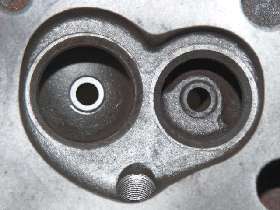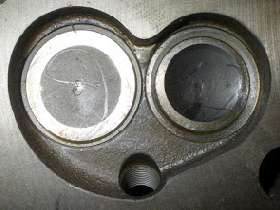The MGA With An Attitude
The WESLAKE PROMONTORY -- CH-100C
In the early 1950's combustion chamber and port design for the new BMC engine series was handled by a well-known consultant named Harry Weslake. Spending much time pumping air through wooden port models, checking, chopping, and filling with files and plasticine, they came up with a unique heart-shaped chamber which promoted turbulence and coolness of the incoming mixture.


On left, combustion chamber in a "15" head from an MGA 1500/1600 engine. On right, combustion chamber in a "16" head from an MGA 1622 engine. The later model has larger combustion chamber and much relieved promontory point on the heart shape between the valves. The Austin B-series engine appeared first in the MG ZA Magnette in 1953, then later in the ZB Magnette and MGA in 1955.
The "15" heads have round intake ports for early heads and larger rectangular intake ports for later heads (round at the gasket surface but rectangular farther in). All "15" heads should have 38cc volume combustion chamber, with one exception. When the 1622 engine was introduced in the MGA it was given a larger combustion chamber (43cc), one size larger valves and better porting. A few hundred "15" heads were machined to "16" specification before the new "16" castings were available.

When rebuilding the "15" head it is advantageous (and highly recommended) to round off all sharp edges in the combustion chamber. Also round off and somewhat relieve the point of the Weslake promontory. This is to remove hot spots that may cause detonation, spark knock, and run-on after shut-down.
Larger valves are sometimes installed in the "15" head during a rebuild. Special attention should be paid to "shrouding" of the valve heads. When the valve head is too close to the chamber wall it inhibits air flow. The chamber wall may then need to be relieved to provide sufficient working clearance. As the combustion chamber is slightly enlarged by de-shrouding and modification of the promontory, the bottom surface may be shaved slightly to reduce chamber volume to the original specification.
The "16" head is nearly identical to the early MGB "18" head, except for a small difference in the Weslake promontory. To have the appropriate compression ratio with the larger combustion chamber the MGA 1622 engine was built with flat top pistons. Pistons in the 1800 to follow were slightly dished. Having been used for only 14 months of production in the MGA, the "16" head is rather rare today. The early "18" head is suitable as a replacement for the MGA 1622 engine. In general, any Austin B-series engine head will bolt onto any B-series engine block (except for the Twin Cams). Pay attention to chamber volume and resulting variations in compression ratio.
|